| Home | Nature Weekly Index |
27 April 2025 | Madagascar Periwinkle | Catharanthus roseus |
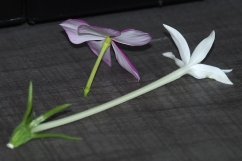 |
| Fig. 1: Flowers of Catharanthus roseus and Hippobroma longiflora |
The Madagascar Periwinkle (Catharanthus roseus), as its name suggests, is native of Madagascar, an island country located off the southeastern coast of Africa. In December last year, I discovered a seedling of this plant growing in my pot unexpectedly. The origin of the seed remains unknown. A month later, it produced its first bright pink flower. The corolla of the flower is fused at the base, forming a narrow long neck about 25 millimetres in length, with five petals at the distal end. This extended corolla neck bears a resemblance to another herbaceous plant in my pot, Hippobroma longiflora (Star of Bethlehem), which has white flowers and a significantly longer corolla neck, approximately 90 millimetres long (Fig. 1). Catharanthus roseus is frequently cultivated as an ornamental plant and is recognized as naturalised based on the 2022 Singapore flora checklist (page 158).
Prior to the appearance of this plant, my website contained only 4 old images taken in 2008. With the addition of the live specimen, the number of images has increased, with improved quality. Over the past few months, the plant has continued to grow and extended more branches. It also produced numerous flowers concentrated at the distal end of the branches. Initially, most of the flowers withered without producing fruit. Early this month, the first pair of elongated fruits (follicles) appeared (Fig. 2). When fertilised, the withered flowers remain attached to the plant until the paired unripe follicles reach a certain length. Non-fertilised flowers fall off while still fresh. As the plant grows taller, more fruits appear. Unlike Catharanthus roseus, every flower of Hippobroma longiflora is fertilised, producing a single two-compartment fruit (capsule) (Fig. 3), with the long-withered flower remaining attached to the capsule indefinitely.
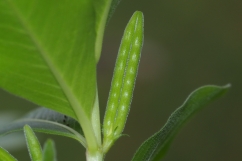 |
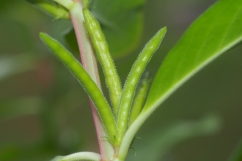 |
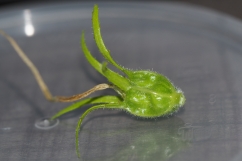 |
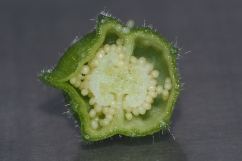 |
| Fig. 2: Paired fruits (follicles) of Catharanthus roseus | Fig. 3: Fruit (capsule) of Hippobroma longiflora | ||
To date, the Catharanthus roseus plant has shown resistance to pests. Despite the presence of various plant pests affecting other nearby plants, this species has not exhibited any signs of infestation. The foliage remains robustly green with numerous pink flowers clustered at the end of each branch.
| 13 March 2025 | 26 March 2025 |
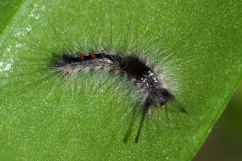 |
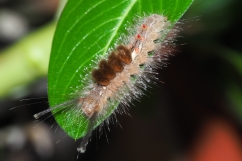 |
| Fig. 4: Caterpillar of Zhejiang Tussock Moth (Dasychira chekiangensis) found on my plants | |
On 13 March, I observed a small, hairy caterpillar on a Talinum paniculatum (Jewels of Opar) in my pot, which I suspect to be a caterpillar of the Zhejiang Tussock Moth (Dasychira chekiangensis) (Fig. 4). I commenced daily monitoring of its movements. The caterpillar was initially feeding on the leaves of Talinum paniculatum. However, due to concerns regarding the sufficiency of these leaves over time, I decided to introduce it to the leaves of Catharanthus roseus.
On 22 March, I transferred the caterpillar to the Catharanthus roseus plant. It appeared to adapt well, as it began consuming the leaves immediately and moved actively around the plant. Nevertheless, it only consumed approximately two leaves per day, which did not pose a significant risk to the healthy and bushy host plant. Occasionally, it also fed on the flowers. Unfortunately, the caterpillar disappeared on 27 March. It is possible that it relocated to undergo metamorphosis or was preyed upon by predators.
The Zhejiang Tussock Moth has not been uncommon on my potted plants, as I have observed it on several occasions. The most notable instance occurred in July 2020 when I followed the caterpillar's progress until it transformed into a moth. Remarkably, the newly formed moth subsequently laid numerous eggs, which eventually hatched into caterpillars. All these events transpired on my balcony at that time.
I suspect that the current vegetation on my balcony is insufficiently dense to provide a suitable environment for the caterpillar's metamorphosis compared to the conditions in July 2020. It is likely that the caterpillar has chosen an alternative location to undergo its transformation.